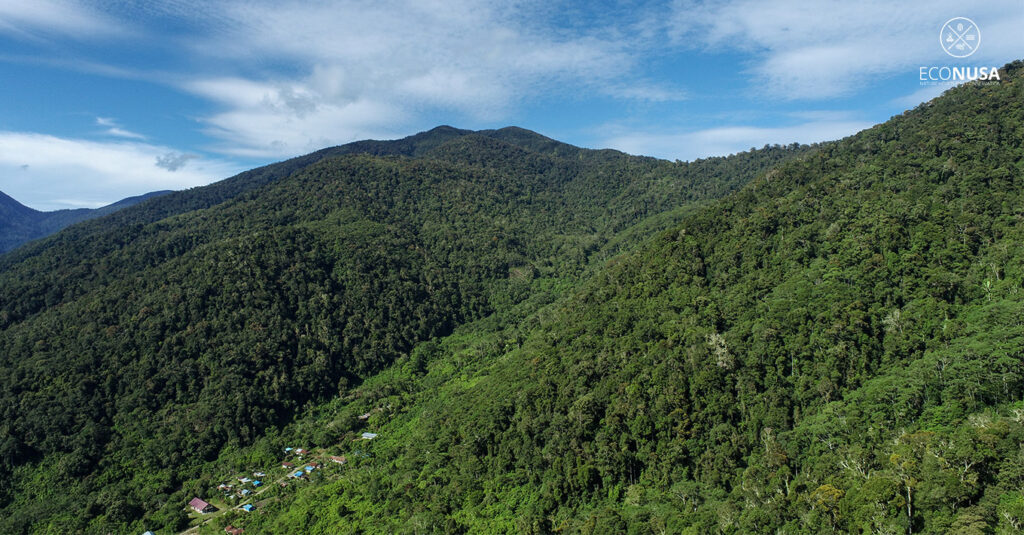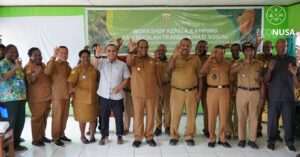
Arfak Tribe living surrounding Arfak Mountain in West Papua Province agreed to split plot of various aspect of life through a so-called igya ser hanjob. This is a local language to express local wisdom from generations to generations that survives community life for a longer life. The United Nations Educational, Scientific, and Cultural Organization (UNESCO) established igya ser hanjob as the world heritage.
As to Purbokurniawan et.al. , Igya ser hanjob is derived from Hatam local language. Igya means standing on our own feet. Ser means taking care, and hanjob means border. Thus, the free meaning is “standing to defend the border”. Border is not only meant on the customary land, but rather cultural and natural richness, and food estate. “The principle here is deemed local ideas of Arfak Tribe which is wise, pious and valuable,” Purbokurniawan et.al. wrote in “Zona Pemanfaatan Lahan Pertanian ‘Igya Ser Hanjob’ di Sekitar Danau Anggi, Pegunungan Arfak, Papua Barat (Utililzation Zone for Agricultural ‘Igya Ser Hanjob’ Surrounding Anggi Lake, Arfak Mountain, West Papua)”, a national seminar proceeding on agrotechnology 2019.
Arfak Mountain compound is inhabited by some Tribes such as Hatam, Meyakh, Sough, and Moile. The local community commonly relies their lives on both nomadic farming and permanent agriculture. To utilize land, Arfak community keeps ecological values in the igya ser hanjob in their mind.
Read also: Cenderawasih Significance in Rainforest Ecosystem Stability
Igya ser hanjob divides customary areas into four parts, namely Bahamti, Nimahamti, Susti, and Situmti. Bahamti is the primary forest which is strictly prohibited from any activity. Hunting, gardening, and gathering are strictly banned in the Bahamti areas. All violations will carry customary penalties in the forms of money, livestock, or labor, and moral sanction such as public exile.
Division of Customary Area
Bahamti areas are marked by large-sized and high trees. The trees are very dense in the area. Not only large diameter trees, but moss vegetation is also found in Bahamti areas covering the ground as well as the tree trunk.
Nimahamti is also deemed secondary forest areas. Formerly, Arfak Tribe cultivated the areas into plantation. After leaving the areas for a long time, the areas turned to be forest. The abandonment period here is locally called bera period. At least, bera period lasts for 20 years.
The principle here is deemed local ideas of Arfak Tribe which is wise, pious and valuable
Typologically speaking, Nimahamti area is marked by quite large-sized trees but not as high as the Bahamti’s. The area, as the former plantation, is also characterised by newly grown small trees and there is no rattan nor pandanus.
“The Nimahamti area is deemed limited cultivation area which serves as the buffer zone. The area could also serve as the reserved areas because it could be re-utilized after recovery,” wrote Purbokurniawan et.al. The natural use such as gardening, wood picking, hunting, tree planting should be upon the customary leader’s approval. It also includes the reconstruction of a hut during land clearance for gardening because there is no more area left at Susti area.
Read also: Travel Diary: Tracking Arfak Mountain Splendor
Susti is the areas producing major food for Arfak communities from nomadic agriculture. Susti is characterized by homogenous trees including ferns and grasses. Arfak people commonly plants sweet potato, cassava, taro, corn, and potato.
Meanwhile, Situmti is habitation area. Initially Situmti was plantation areas (Susti) but then there was thousand-pillars house as the traditional dwelling for Arfak Tribe which later grows into habitation areas. In addition to Susti area, the locals also plant many kinds of plants for foord and horticulture surrounding their houses.
Categorization of customary land through igya ser hanjob local wisdom also considers topographic condition. The ban of all activities on the Bahamti area for instance, will affect the sustainability of Arfak Mountain ecosystem. The topography of Bahamti will not be proper for food processing.
In the study conducted by Merry Toansiba et.al. published in the Indonesian Agricultural Science Journal, Tinus Towansiba, a villager of Taige in Taige District, said that the topography of Bahamti area is not fitting for agriculture. “Bahamti has rocky areas. We fear that it would slide when we cultivate the land, and the mountain is too high.”
In the morning after waking up at home, the parents usually advise the children of Arfak Mountain so that they care about their residences, they do not take and trespass others’ property
Lukas Towansiba of Taige Village gave similar statement. The community would be hard to cultivate the land noting the fact that the area is located at the top of Arfak Mountain and far from residence. “We are getting older with less energy. So, we are not strong enough to walk far away. We are scared if there is landslide. Besides, it is rocky ground,” said Lukas.
Read also: Getting to Know Four Endemic Cenderawasih in Arfak, West Papua
According to Merry Toansiba et.al., the Arfak Tribe’s knowledge on land cultivation goes along with sustainable agriculture similar to the LEISA (Low External Input Sustainable Agriculture) system. The LEISA system optimizes plants, livestock, soil, water, climate, and human to sustain the soil fertility for the long run while keeping the ecosystem.
Traditional Knowledge Legacy
Through igya ser hanjob, the Arfak community rotated the ground by applying bera system. They put leave and grasses to nurture the soil with nutrient. Selection of land for gardening should consider soil fertility as top priority. The Situmti area has black soil as the fertile ground.
After two crop seasons, the soil quality at the Situmti area declines. The locals apply bera period from two up to three months while giving fertilizer. As to Tinus, the fertilizer is processed by using certain plants such as sibe, arwop leave and amucro grass. “Children get knowledge on farming based on ecological principle because they often come along with their parents for farming,” wrote Merry Toansiba et.al.
Direct legacy of traditional knowledge was agreed by Alfa Ahore, a young girl from Arfak Tribe. Alfa said that their parents shared traditional knowledge in the thousand-pillars house while giving advice to their children. The conveyance of traditional knowledge is commonly done at night before sleeping and when they do farming or passing through the forests.
“The igya concept happens just the way it is. In the morning after waking up at home, the parents usually advise the children of Arfak Mountain so that they care about their residences, they do not take and trespass others’ property. They got information on their own property borders to prevent them from trespassing other peoples’ areas,” said Alfa to EcoNusa at Kwaw Village.
Editor: Leo Wahyudi







